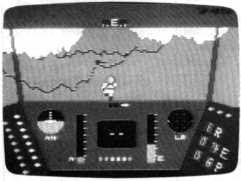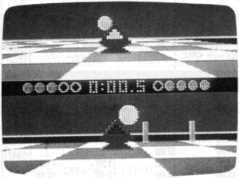Reviews
Rescue On Fractalus!
And Ballblazer Tom R. Halfhill, Editor
Requirements: Atari 400/800, XL, or XE computer with at least 48K RAM, a disk drive, and a joystick (two joysticks are recommended for Ballblazer). Versions for the Commodore 64 and Apple II-series computers were due to be released early this summer (except for the 64 version of Ballblazer, which is still under development).
Delayed for a frustrating year by the turmoil of the home computer wars, Rescue on Fractalus! and Ballblazer have finally hit the market for Atari computers and are pending for the Commodore 64 and Apple as well. It's about time, too, because these action games have been anxiously awaited since their unveiling in mid-1984. Designed by Lucasfilm-the production company which brought us the Star Wars trilogy-both games were supposed to be marketed in cooperation with Atari. Unfortunately, Atari fell on hard times and the Lucasfilm games fell into limbo.
For a while, enthusiasts wondered if the games would ever see the glow of home video screens. Tantalizing preproduction copies of Ballblazer were known to be circulating in the pirate underground. Finally, Epyx, Inc. clinched a deal with Lucasfilm to market the programs. Now everyone can decide: Were they worth the wait?
A Mission Of Mercy
Rescue on Fractalus! integrates the best features of Broderbund's Choplifter, Atari's Star Raiders, and Microprose's Solo Flight. Similar to Choplifter, your mission is to locate and rescue fellow pilots stranded in enemy territorywhile fighting off hostile aircraft and ground targets. As in Star Raiders, you fly a spaceship from a first-person perspective-the video screen is a windshield onto the world beyond. And like Solo Flight, success depends on your ability to skillfully maneuver over an ever-changing landscape-while keeping an eye on your flight instruments at the bottom of the screen.

Rescue on Fractalus!: As you look out onto
the jagged mountains of Fractalus, a downed
space pilot runs for the safety of your airlock.

Ballblazer: With only a half-second left to
play and the score 4-3, player two (bottom
window) tries to shove the Plasmorb past
player one (top window) and into the goal.
The scenario is that a number of space pilots have been shot down by alien Jaggies on the planet Fractalus. (The planetary landscape is generated by fractal mathematics-get it?) You're an old-fashioned air pilot who has been called back into the Ethercorps to rescue the downed space pilots. Launched from an orbiting mother ship, you have to save a certain quota of pilots during each mission to advance to the next level. The task involves locating the pilots one by one, landing within walking distance, waiting for the pilot to enter your airlock, and then taking off again to resume the search. When your quota is filled, you return the pilots to the mother ship. Meanwhile, you have to duel with Jaggi gun emplacements dug into the mountainsides and fight off kamikaze attacks by Jaggi saucers.
Your craft, a modified Valkyrie-class fighter, is equipped with defense shields, Antimatter Bubble Torpedos, a targeting scope, a long-range scanner that picks up the presence of nearby space pilots, and a detector that warns when a Jaggi gun has locked onto your ship. Flight instruments include an artificial horizon, an energy-level meter, two altimeters, a compass, a speed indicator, a device that shows the clearance between your wingtips and the canyon walls, and digital readouts that tell how many Jaggies you've destroyed, how many pilots you have to rescue, and your distance from the pilot on the long-range scanner. All these dials and gauges are especially important on the highest levels, because you have to fly at night on instruments only.
A team of eight people created this game, and the attention to detail shows. In fact, the flight simulation could be a game in itself. You can climb, dive, and bank by steering the sensitive joystick, and keyboard controls let you speed up, slow down, land, switch your shields on and off, and open the airlock doors. Sound effects are rich: the whine of your engines, the explosions of torpedos and Jaggi gunshots, the anxious knock of pilots pounding on your airlock door to be rescued, and the hiss of the door as it opens and closes. Even the documentation is entertaining and professionally done.
Rescue on Fractalus!, like Star Raiders, calls for strategic thinking and contains some surprises and secrets for you to discover before you can move to the highest levels. It's definitely not a fastpaced twitch game. Indeed, at times it moves rather slowly as you search for the stranded pilots. But overall, it's an exceptional effort.
Split-Screen Soccer
Lucasfilm's other release, Ballblazer, is equally impressive. The split-screen, high-speed graphics of this frenetic game must be seen to be believed. Like Rescue on Fractalus!, it's a first-person perspective game that shows you the view from the driver's seat. But Ballblazer goes a step further and actually splits the screen into two views-one for each player. Two people can compete using two joysticks, or one person can play the computer.
Essentially, Ballblazer is space-age soccer played on a checkered field that measures 21 squares wide by 55 squares long (each square represents 5 X 5 meters). The Grid, as it's known, has a pair of goalposts at each end and is surrounded by force fields to keep players from straying out of bounds. As in soccer, the object is to score more goals than your opponent.
Unlike old-fashioned soccer, however, this game isn't played by teams of flesh-and-blood athletes trying to kick around a rubber ball. Instead, there are only two players, and each one drives a fast-moving hovercraft called a Rotofoil. The "ball" is a Plasmorb, a glowing object that floats two meters above the playing field. When you push the joystick forward to cruise over the Grid, your Rotofoil automatically points itself toward the Plasmorb. When you make contact, a force field grabs the Plasmorb and locks it in front of your Rotofoil. Then the Rotofoil reorients itself toward your goal, and away you go.
If you shove the Plasmorb between the goalposts, you get one point. By pressing the joystick button, you can also shoot the Plasmorb forward, recoiling your Rotofoil backward. By shooting the Plasmorb through the goal at close or intermediate range, you can score one or two points. You can even get three points by scoring a goal with an over-the-horizon shot (since the Grid is slightly curved, the goalposts are invisible at long range).
Meanwhile, of course, your computer or human opponent pursues in another Rotofoil, trying to block your shots and steal the Plasmorb. Whoever scores the most goals before the clock expires-usually three minutes-is the winner.
Like most sports, Ballblazer appears simple but actually contains many hidden strategies and possibilities. Championship play requires good defensive as well as offensive tactics. You can develop these skills by playing practice games against the computer (with adjustable difficulty levels) and by studying the amusing manual. Ballblazer looks like a three-point goal for Lucasfilm and Epyx.
Rescue on Fractalus!
Ballblazer
Epyx, Inc.
1043 Kiel Court
Sunnyvale, CA 94089
$40 each